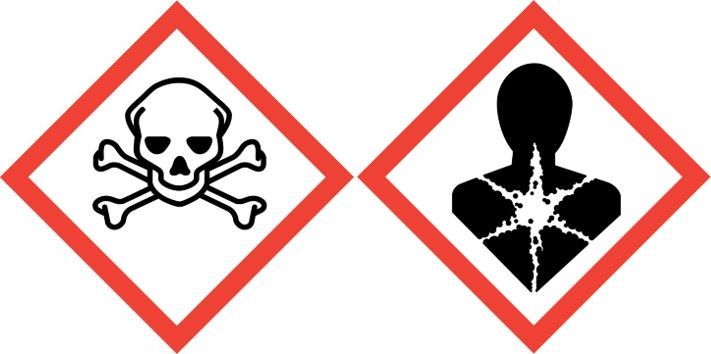When working with chemicals it is important that you know the precautions related to labelling, classification, H-statements, CMR-substances, risk assessments, waste management and chemical inventory, as well as have the necessary training.
Labelling of chemicals
It is EU's CLP regulation that is in used when labelling chemicals. The legislation ensures that the hazards presented by chemicals are clearly communicated to workers and consumers. Chemicals are labelled with hazard pictograms and H-statements that describe the chemical's intrinsic properties.
EU's REACH regulation aims to improve the protection of human health and the environment from the risks that can be posed by chemicals.
Working with GHS06 and GHS08
All work with chemicals labelled GHS06 og GHS08, should be performed in a fume hood. No one should be exposed to these chemicals. Accidents/spills must be reported via Speak up!
work with chemicals labelled GHS06 og GHS08, should be performed in a fume hood. No one should be exposed to these chemicals. Accidents/spills must be reported via Speak up!
Health hazard linked to these chemicals:
- May cause cancer (Carcinogenic), genetic effects (Mutagenic) and/or toxic for Reproduction: H340, H350, H360, H360FD, H360Fd, H360Df)
- Suspected of causing cancer (carcinogenic), genetic effects(mutagenic) and/or toxic for reproduction: H341, H351, H361, H361f, H361d, H361fd)
- May cause allergy or asthma symptoms or breathing difficulties if inhaled (H334)
- Toxic/Deadly if inhaled. (H330, H331)
- Toxic/Deadly if swallowed/skin contact. (H310/H311, H300/H331)
- Target organ toxicity – Single Exposure, Specific target organ toxicity (H370), Repeated Exposure (H371) or chemicals that caused irritation or nausea (H335, H336)
Working with diisocyanates
From 24 August 2023, everyone who uses or handles diisocyanates and diisocyanate-containing mixtures and products must have completed training in safe use. If you are going to work with diisocyanates and diisocyanate-containing mixtures and products, contact the HSE coordinator to receive access to the online training course.
EcoOnline
All Norwegian companies and businesses are obliged to keep a chemical inventory, a complete overview of all chemicals stored and in use. At UiO we use an online chemical inventory called ECOonline.
→
Risk assessment
All work including chemicals should be risk assessed in the form of an SOP.
→
Mandatory training when working with chemicals
Everyone working in the laboratories of the Department of Chemistry must undergo mandatory safety training before commencing work.
Purchase, storage and use of chemicals
Handling of chemicals, including purchasing, registration in EcoOnline, risk assessment, labelling, internal transport, use in the laboratory, storage, and facilitation of laboratory work for pregnant woman, are described in detail in section 8 in the HSE manual.
Laboratory waste and disposal of chemicals
All hazardous waste should be disposed. UiO is practicing a zero waste to drain policy. Follow the instructions in the datasheet and the Hazardous waste guide. Contact the HSE coordinator for disposal.
→ More information about the Department's waste management and hazardous waste
Substituting hazardous chemicals
Substitution means replacing. We have to assess how we use chemicals and, when possible, substitute hazardous chemicals with less hazardous ones. That can be for example to purchase ready made solutions instead of preparing them ourselves or to use greener solvents.
→ Read more about substitution on the
→ Candidate List of substances of very high concern for Authorisation (ECHA website)
→ Read more about Greener solvents on Merck's website
Pregnant in the lab
If you get pregnant, please contact your supervisor, lab manager, the HSE coordinator, the safety representative, and/or BHT for guidance to lab work during pregnancy
Pregnant and breast feeding women cannot not work with CMR chemicals and organic solvents.
